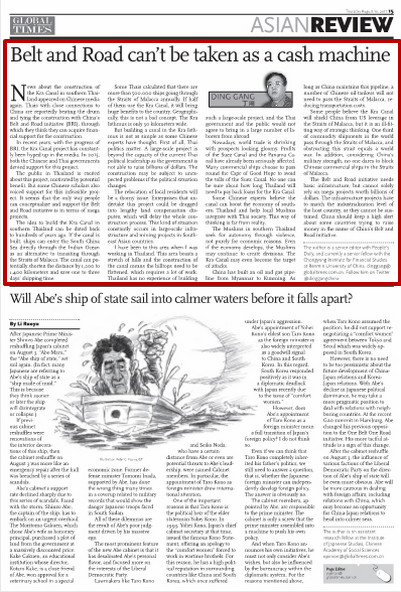Belt and Road
Your Present Location: PROGRAMS> Belt and RoadDing Gang: Belt and Road can’t be taken as a cash machine
By Ding Gang Source: Global Times Published: 2017-8-9
News about the construction of the Kra Canal in southern Thailand appeared on Chinese media again. Thais with close connections to China are reportedly beating the drum and tying the construction with China`s Belt and Road initiative (BRI), through which they think they can acquire financial support for the construction.
In recent years, with the progress of BRI, the Kra Canal project has constantly been hyped up in the media. In 2015, both the Chinese and Thai governments denied support for this project.

The public in Thailand is excited about this project, motivated by potential benefit. But some Chinese scholars also voiced support for this infeasible project. It seems that the only way people can conceptualize and support the Belt and Road initiative is in terms of mega projects.
The idea to build the Kra Canal in southern Thailand can be dated back to hundreds of years ago. If the canal is built, ships can enter the South China Sea directly through the Indian Ocean as an alternative to transiting through the Straits of Malacca. The canal can potentially shorten the distance by 1,200 to 1,400 kilometers and save one to three days` shipping time.
Some Thais calculated that there are more than 500,000 ships going through the Straits of Malacca annually. If half of them use the Kra Canal, it will bring huge benefits to the country. Geographically, this is not a bad concept. The Kra Isthmus is only 50 kilometers wide.
But building a canal in the Kra Isthmus is not as simple as some Chinese experts have thought. First of all, Thai politics matter. A large-scale project is beyond the capacity of the current Thai political leadership as the government is not able to raise billions of dollars. The construction may be subject to unexpected problems if the political situation changes.
The relocation of local residents will be a thorny issue. Enterprises that undertake this project could be dragged into lengthy land compensation disputes, which will delay the whole construction process. This kind of situation constantly occurs in large-scale infrastructure and mining projects in Southeast Asian countries.
I have been to this area when I was working in Thailand. This area boasts a stretch of hills and the construction of the canal means the hilltops need to be flattened, which requires a lot of work. Thailand has no experience of building such a large-scale project, and the Thai government and the public would not agree to bring in a large number of laborers from abroad.
Nowadays, world trade is shrinking with prospects looking gloomy. Profits of the Suez Canal and the Panama Canal have already been seriously affected. Many commercial ships choose to pass round the Cape of Good Hope to avoid the tolls of the Suez Canal. No one can be sure about how long Thailand will need to pay back loans for the Kra Canal.
Some Chinese experts believe the canal can boost the economy of southern Thailand and help local Muslims integrate with Thai society. This way of thinking is far from reality.
The Muslims in southern Thailand seek for autonomy through violence, not purely for economic reasons. Even if the economy develops, the Muslims may continue to create divisions. The Kra Canal may even become the target of attacks.
China has built an oil and gas pipeline from Myanmar to Kunming. As long as China maintains this pipeline, a number of Chinese oil tankers will not need to pass the Straits of Malacca, reducing transportation costs.
Some people believe the Kra Canal will shield China from US leverage in the Straits of Malacca, but it is an ill-fitting way of strategic thinking. One third of commodity shipments in the world pass through the Straits of Malacca, and obstructing this strait equals a world war. In addition, considering China`s military strength, no one dares to block Chinese commercial ships in the Straits of Malacca.
The Belt and Road initiative needs basic infrastructure, but cannot solely rely on mega projects worth billions of dollars. The infrastructure projects have to match the industrialization level of the host country, or they cannot be sustained. China should keep a high alert about some countries trying to raise money in the name of China`s Belt and Road initiative.
The author is a senior fellow with the Chongyang Institute for Financial Studies at Renmin University of China.
Key Words: Belt and Road;China;economic























































































 京公网安备 11010802037854号
京公网安备 11010802037854号





